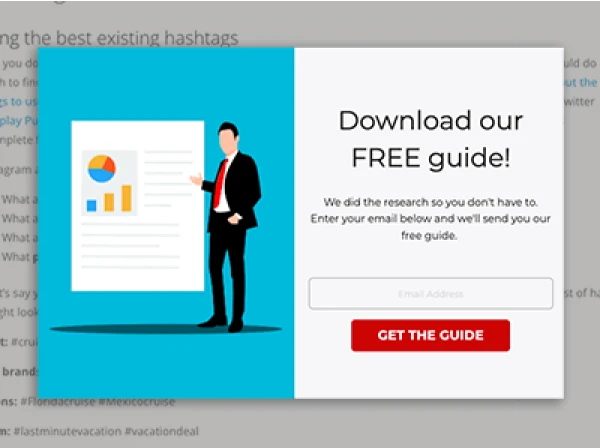The 12 Best Ways to Build Trust For Your Business in a Skeptical Online World
Learn how to build trust with skeptical online customers through video testimonials, third-party reviews, professional website design, and more.
Why should someone trust your business?Maybe they find you by typing a query into Google. Or perhaps they stumble across your business from a Facebook ad or a link from someone else’s website…At this point in the relationship, you’re nothing but a stranger.Yes, they’ve found their way to your website, but what makes you any more trustworthy than the person handing out fliers for a meal delivery service at your local train station?
Online businesses too often take trust for granted. We think that just because our product is great and people come to our website that the exchange of sale will take care of itself.
Unfortunately, our prospective buyers are naturally skeptical. Skepticism is rife in the online world where scams, pyramid schemes, and dodgy marketing tricks and tactics are all too common.So, then, how do you build trust with the skeptics? Here are 12 of the best ways to do so.
#1. Video testimonials
If you can entice your happy customers to provide video testimonials, they give you one of the best trust-building forms of content available. Face-to-camera video has a way of creating a personal connection with viewers, which builds trust in and of itself. This combined with the fact that someone who is a seemingly independent third-party is recommending your product, video testimonials are an unstoppable trust-builder.The key to a great video testimonial is two-fold;
- It needs to be high-quality. Professional editing makes a huge difference when trying to establish trust with prospects.
- It needs to follow a proven structure that talks to your customer’s unique situation - making them resonate with the individual in the video. Have your customer answer a series of questions that aligns with a structure like this; The problem they were trying to solve prior to finding your business > How using your product or service helped alleviate that problem > Their main concern prior to working with your business > How they overcame that concern > The results or accomplishments they have achieved by using your product or service.
eCommerce platform Shopify showcases customer stories via video testimonials on their homepage:

How Shopify use video testimonials.
#2. Third-party reviews
Yes, video testimonials are great for growing trust with prospects, but they can still garner a sense of skepticism. After all, your business has likely filmed, edited, and orchestrated these videos. If you can, combine these testimonials with third-party customer reviews.Third-party customer reviews are real and genuine opinions or ratings posted by your customers on other websites. For example, your customers may review your business on Facebook or Google. There are also a number of independent product comparison and review websites where your customers can share their experience with your brand. Look to earmark a shortlist of the best websites for this purpose and actively encourage your customers to post reviews. Then, share these reviews and your overall rating on your website.Kitchenware brand, Tefal, has even dedicated a page on their website to the awards and reviews they have received from third-party review website Product Review:

Using customer reviews on your website.
#3. Professional website design
46.1% of people say that a website's design is the number one criterion for discerning the credibility of the company. Yet, many businesses haven’t updated or improved the aesthetic design of their web experience for over a decade.
46.1% of people say that a website's design is the number one criterion for discerning the credibility of the company."
Here are some tips for ensuring your website design looks professional:
- Maximize white space. This helps our eyes make sense of what we are reading and draws us to the most important points, highlighted by other colors.
- Optimize for mobile devices. We spend 3 hours and 15 minutes on our mobile device every day on average, and these days, Google is giving prominence to mobile responsive sites in their search results. Test your site to see if it is mobile-friendly using Google’s free tool here.
- Simplify navigation. Effective site navigation is about more than just your top menu, it is about helping your visitors find their way around your site, in a targeted and specific manner.
- Create (and follow) a style guide for your brand. Include things like colors, fonts, logo variations, the tone of voice, and brand personality.
#4. Clear and visible contact information
There is nothing worse for a website visitor than if they can’t find a way to contact you. This creates frustration and distrust. Think about it, would you trust a business that looks as if they are hiding their identity or avoiding contact with people? I wouldn’t.Clearly showing your contact information on your website - phone number, address, and email address - puts visitors at ease knowing that if they ever have a problem they will be able to get in touch. It also sends credibility signals to Google if your contact information matches up with your local business data.Popular Australian ice cream parlor, Messina, makes it super-easy for people to contact them with their details clearly visible on both Facebook and their website:

Visible contact information to build trust.
#5. Fast response times
Leading on from the point above about contact information, you also need to ensure that you respond to people once they contact you. There is no point in having an easy way for people to get in touch unless you are ready and willing to handle these requests. In fact, by not responding, you lose even more trust than if you had not had the contact information available in the first place!Consumers desire a fast and efficient response from companies, which is exactly why Facebook gives this prominence on business pages. If you are responsive to messages, you are rewarded with an eye-popping green label that says so:

Responsive customer service on Facebook.Use this Facebook feature to your benefit by responding quickly, and building trust with new prospects who check out your page.
#6. Be human
People want to connect with people, not brands. So take every opportunity you can to personalize your online experience and it will establish a trusting relationship with your potential customers.
Take every opportunity you can to personalize your online experience and it will establish a trusting relationship with your potential customers."
Some examples of humanizing a brand include:
- Writing a personal ‘About us’ page with photos of your team.
- Hero-ing your employees by giving them a voice on social media and as the author of blog posts.
- Sharing behind-the-scenes videos and photos of how your business operates day-to-day on social media.
#7. Minimal technical issues
It’s extremely frustrating for users when a website has technical issues. For example, let’s say you click on a link and the page doesn’t load, or you see a 404 error. Not only will this reduce the chance of a user taking action on your website, but it can also diminish their trust for your business.You should regularly check for technical problems with your website and fix any issues as fast as you can so that users aren’t put off your brand. You can use the Google Search Console to check for 404 errors, as an example.
#8. Guarantees, badges, and awards
Awards, badges, and money-back guarantees are another way to alleviate your web visitors’ concerns about the trustworthiness of your business. A guarantee lets people know that you aren’t simply after their money, but that you actually want to deliver them a valuable product and experience.See how social media video software Ripl use this trust-building tactic on their homepage by displaying partnership badges and awards:

Trust building by using badges and partnerships.
#9. Quality content and an active social presence
Whether you run a blog, YouTube channel, host a podcast, or just publish quality content on your social media pages, it contributes to the trust equation with your prospects.The thing about non-promotional content is that it takes a lot of time and effort to create, and technically, you aren’t ‘required’ to produce it. People respect this effort. It tells them that you are willing to go above and beyond to entertain them or solve their problems, without asking for a credit card.Skydiving company, Skydive Oz, regularly shares amazing video content of customer experiences on their social media pages and blog which develop trust for their service:

Building trust with quality content.
#10. Two-way dialogue with customers
Your customers want to be heard. If they have an issue, whether it’s a technical problem on your website or a faulty product they receive, you need to respond to them quickly and openly. Especially if they air their concerns publicly on platforms such as social media or product review platforms.In some instances, a frustrated customer can be recovered with a simple act of attentiveness and action. Don’t leave them hanging because all it will do is compound the frustration and develop into anger towards your business.By creating a two-way dialogue with customers online you show that you care. You are willing to go above and beyond to handle their concerns and rectify any misunderstandings. Others that see this approach will have increased trust for your business by association.
#11. User-generated content (UGC)
User-generated content (UGC) transforms consumers from passive viewers into active advertisers of your business. Their motivation to create this kind of content derives from their desire to play a greater part in your brand’s community of followers and connect with other like-minded individuals.UGC comes in several different forms, from blog posts to videos to customer reviews. One of the most powerful forms of UGC trending at the moment is photos and videos shared by brand advocates on social media platforms. Brands that execute this kind of strategy successfully are able to generate a library full of trust-building content that is created by their happy customers.Dog camera brand, Furbo, uses the branded hashtag #CaughtOnFurbo to collate funny and entertaining content from their customers:

User-generated-content from Furbo.
#12. Interactive experiences
Interactive experiences encourage users to respond and engage with certain stimuli, for example, taking a quiz, watching a video, or participating in a contest. It is a fluid and elastic strategy which changes based on an individual’s responses - making it highly personalized.Through personalization, interactive experiences keep your prospects engaged for longer periods, which grows trust for your brand and makes it more memorable.
Through personalization, interactive experiences keep your prospects engaged for longer periods, which grows trust for your brand and makes it more memorable."
Conclusion
We live in a digital world that is burdened by skepticism and untrusting consumers. Of course, this is not your brand’s fault - but many businesses before you burned down the online pyramid of trust by ripping people off.Unless someone is personally recommended to your business, they are unlikely to trust you after one or two interactions. Instead, they require multiple touchpoints across various channels, combined with social proof and trust elements in order to take the plunge.There are, however, a variety of tactics you can use to accrue trust at a faster rate with your prospective customers, a number of which have been mentioned in this article.Take a moment to look at your online presence from a complete stranger’s perspective and ask yourself; are you really that trustworthy?
Try making a free contest or promotion to gather leads from your social media.
Get Started Today. No credit card required. Risk-free.
About the author
Will Blunt is the founder of Sidekick Digital by Will Blunt - B2B Marketing Expert - Sidekick Digital, a publishing business that launches, manages, and grows brands with content marketing.
Recent posts
Go back to blogGet marketing tips straight to your inbox
Launch an irresistible giveaway. Get started for free.
Join 630.000+ marketers that are boosting engagement and sales.













